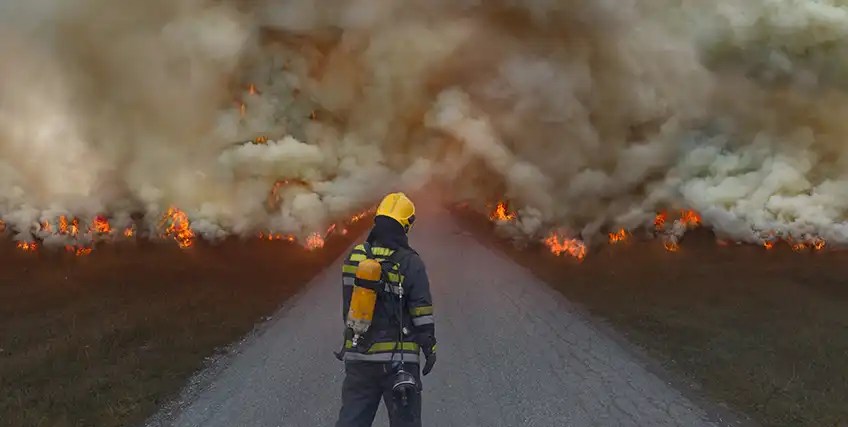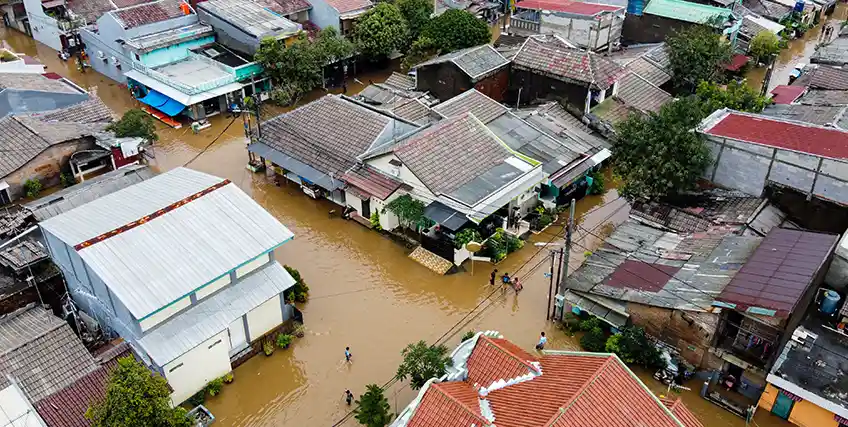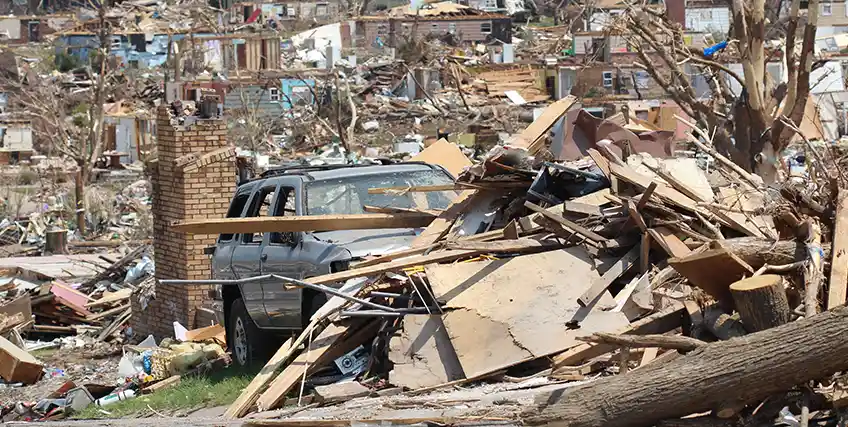How to Qualify for SBA Disaster Loans in 2025
July 1, 2025 | Last Updated on: July 2, 2025

The U.S. Small Business Administration (SBA) is a federal government office that helps businesses and nonprofits find business funding when they’re unable to do so from traditional sources like banks or online lenders. This United States government agency also offers disaster loan assistance for businesses and nonprofit organizations that are experiencing hardship after natural disasters like wildfires or other unpredictable events. Known as economic injury disaster loans (EIDL), SBA disaster loans can be a major asset after something outside of a business owner’s control impacts their revenues. Here, we explore how they work in 2025.
In this article:
- Eligibility requirements for SBA disaster loans in 2025.
- Changes to SBA funding processes this year compared to previous years.
- How to qualify and apply for SBA disaster loans.
Eligibility Requirements for SBA Disaster Loans
SBA disaster loans do not follow the same eligibility requirements and guidelines as popular programs like 7(a) and 504 loans. Nonetheless, businesses of all sizes can get SBA disaster loans, provided they have been impacted by a disaster. These loans provide the necessary working capital to help small businesses bounce back after a disaster until their normal operations resume.
The general eligibility requirements for small business disaster loan assistance dictate that eligible businesses must:
- Be an operating business.
- Operate for profit.
- Be located in the U.S.
- Meet SBA small business size requirements.
- Not be an ineligible type of business.
- Be unable to obtain the desired credit on reasonable terms from non-federal, non-state, and non-local government sources.
- Be creditworthy and be able to show a reasonable ability to repay the loan.
In addition to these basic SBA loan requirements, SBA disaster loans have a few additional layers of eligibility confirmations.
The SBA clarifies that qualifying businesses must have endured financial economic injury from a disaster. This means that the business is unable to meet its financial obligations and pay its regular, necessary operating expenses. Importantly, loss of expected profits or a decline in sales is not considered a qualifying event for SBA disaster loans.
The SBA requires that businesses must meet the following criteria to qualify for SBA disaster loans:
- The business was directly impacted by the disaster.
- The business cannot cover expenses due to the disaster and/or debt.
- The business was physically located in the declared disaster area.
If qualified, the amount you can receive from the SBA will depend on how much financial impact you have experienced and the financial needs your company has to cover the costs and expenses it would have been able to handle if the disaster had never happened.
Importantly, there needs to be a disaster declaration. For businesses, there is another SBA Disaster Assistance program that functions as a physical damage loan, known as business physical disaster loans, that help cover property damage to business properties. Businesses can get a combined loan amount of up to $2 million through both disaster loan programs.
Use of Proceeds
In addition to the general eligibility requirements, SBA disaster loans also have use of proceeds regulations. Low-interest disaster loans can be a welcome infusion of capital to your business, but you can’t spend the money on just anything.
You may use EIDL funds for working capital and normal expenses, such as the continuation of health care benefits, rent, fixed debt payments, and utilities.
You must not use EIDL funds for:
- Expanding facilities
- Buying fixed assets
- Paying out dividends or bonuses
- Paying back loans to stockholders or principals
Effectively, this means that SBA disaster loans should not be misused as money to support growth, expansion, or innovation. They are designed to help businesses recover after disasters, not profiteer from them. It’s important to keep this in mind as you use funds because the SBA will typically request to review receipts of how you used EIDL funding. It’s imperative that you can account for at least 80% of the money going towards approved uses.
How Do SBA Disaster Loans Work?
Disaster loans are for businesses located in areas impacted by disasters, as declared by the Federal Emergency Management Agency (FEMA) in Washington. These loans have very favorable terms for qualified business, including an interest rate that will not exceed 4%, no interest accrual for the first 12 months, and a first payment that’s deferred for 12 months.
These loans have up to 30-year terms, determined by the ability to repay the loan, and there’s no pre-payment penalty or fees. However, loans over $50,000 do require collateral, such as real estate or business equipment. You may use personal property as collateral, but it’s not advisable, just in case you do struggle to repay the loan. Should you default on the loan, the lender and SBA may repossess the collateral, and you certainly don’t want that to happen to valuable personal property.
How to Apply for SBA Disaster Loans
If your business meets the eligibility requirements, you may apply for SBA disaster loans online at SBA.gov. The step-by-step process is fairly straightforward:
- Use the SBA’s E-Tran system to find a lender and apply for funding with your contact information. All borrowers must submit a date of birth for all owners, ownership structure, citizenship or Lawful Permanent Resident (LPR) documentation, alien registration numbers (if applicable), and an environmental review if real estate is involved.
- Submit your documentation, like financial statements showing how much funding you need, and proof that you’re in a disaster area to streamline the application process.
- Once you’ve submitted your application, the SBA will send an inspector to estimate the cost of damage and compare to your application.
- If the SBA disaster loan is approved, you’ll receive funding in your business bank account. Remember to keep accurate, meticulous records of how your business uses the loan proceeds.
2025 Changes to SBA Disaster Loan Application
According to recent SBA procedural notices, there are four key updates to know for the 2025 SBA loan application requirements. These requirements include:
- Date of birth requirements: As of March 27, 2025, lenders must submit the date of birth for every owner of the applying business in the SBA’s E-Tran system. This information must be manually collected and entered until official forms are updated.
- New environmental review standards: The SBA has changed how it reviews environmental reports. If no contamination is identified, lenders must certify this and maintain an environmental investigation report in the borrower’s file. If there is contamination, lenders may still make loans, but they must comply with the Environmental Policies and Procedures requirements of SOP 50 10 7.1, which may make getting funding more difficult.
- Citizenship and ownership documentation: Business owners must now be 100% owned by U.S. citizens or LPRs. All owners must have fully documented and confirmed citizenship at the time of application. If applicable, alien registration numbers must be entered in E-Tran. No owners may be undocumented individuals, visa holders, or other ineligible persons.
- Beneficial ownership: The SBA requires lenders to list at least 81% of beneficial owners in E-Tran when submitting a loan application. Beneficial owners are anyone with direct or indirect ownership. Essentially, borrowers must certify that none of their listed owners are ineligible.
Final Thoughts
An SBA disaster loan can be a major asset if a natural disaster or other unpredictable circumstance impacts your business’s operations. These loans offer mitigation to help you cover operating expenses while your business recovers, but may not be used as a loan to fuel growth, expansion, or innovation. There are other SBA loans and types of financing for that. There are strict eligibility requirements for SBA disaster loans, so make sure you thoroughly review the guidelines and vet your application before submitting.
FAQs About SBA Disaster Loans
Can you use SBA disaster loans for personal reasons?
Unlike most loan programs, homeowners and renters may actually use SBA disaster loans, too. Low-interest disaster loans can help cover any repair or rebuilding costs that are not covered by private insurance, or disaster-related damage costs that exceed initial estimates.
How much can you get from an SBA disaster loan?
Businesses may borrow up to $2 million through SBA disaster loan programs to account for property damage and/or economic injury. Homeowners may borrow up to $200,000 to repair or replace a primary residence, while both renters and homeowners may borrow up to $40,000 to repair or replace personal items destroyed in a disaster.
What documentation do you need for an SBA disaster loan?
The necessary documentation for an SBA disaster loan includes the dates of birth for each owner, citizenship or lawful permanent residency documentation, clear list of all owners and ownership percentages, recent (less than 1-year-old) environmental reports for real estate-backed loans, and any applicable alien registration numbers or supporting USCIS documents.
Can an SBA disaster loan be used for anything?
Unlike traditional term loans and other more conventional types of financing, SBA disaster loans are restricted to be used only to repair property damage or navigate the financial impact of a disaster. You may not use them to invest in growth, expansion, or innovation.
Do you have to show receipts for an SBA disaster loan?
It’s important to keep receipts for any purchases you make with your loan for at least three years after receiving it. The SBA requires you to show how you spent 80% of your loan to ensure you’re only using the funds in a way that you’re authorized to do so.
Frequent searches leading to this page
Related Articles
How to Apply for an SBA Disaster Loan: Step-by-Step Guide: Which One to Choose in an Emergency?
July 2, 2025




